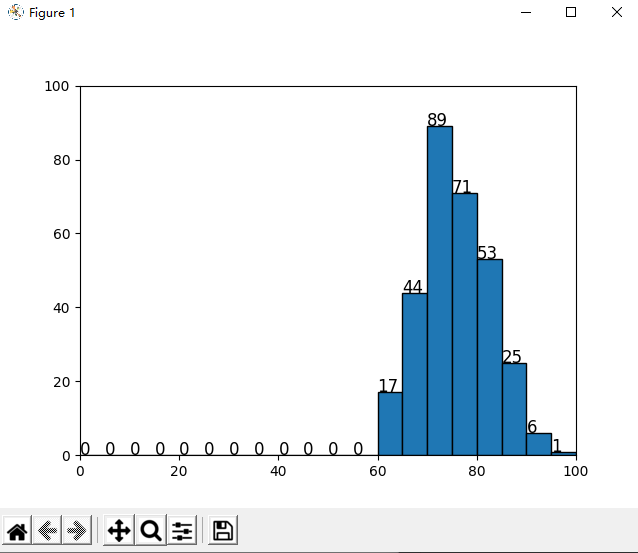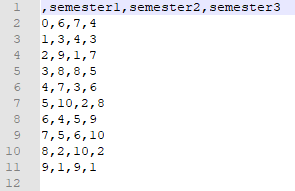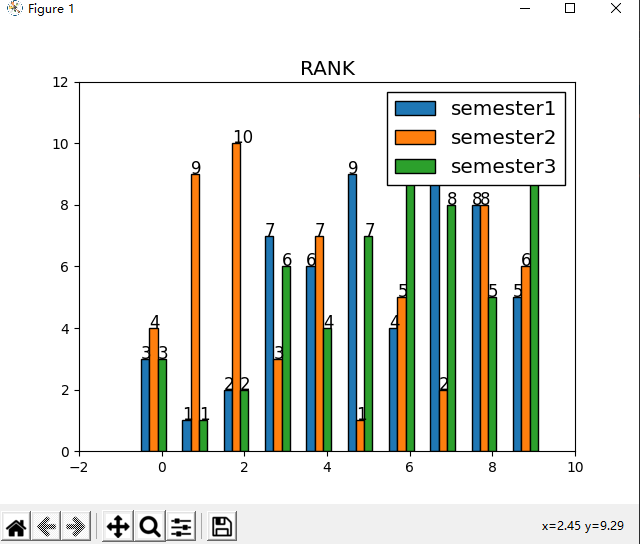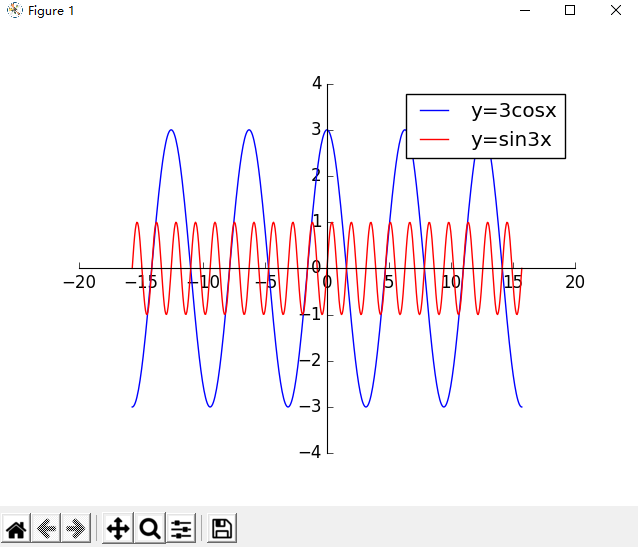1. 问题描述
对右图进行修改 - 请更换图形的风格 - 请将 x 轴的数据改为-10 到 10 - 请自行构造一个 y 值的函数 - 将直方图上的数字,位置改到柱形图的内部垂直居中的位置
-
对成绩数据 data1402.csv 进行分段统计:每 5 分作为一个分数段,展示出每个分数段的人数直方图。
-
自行创建出 10 个学生的 3 个学期排名数据,并通过直方图进行对比展示。
-
线图
- 把这个图像做一些调整,要求出现 5 个完整的波峰。
- 调大 cos 波形的幅度
-
调大 sin 波形的频率
-
用线图展示北京空气质量数据
展示 10-15 年 PM 指数月平均数据的变化情况,一幅图中有 6 条曲线,每年 1 条曲线。
2. 实验环境
Microsoft Windows 10 版本18363
PyCharm 2020.2.1 (Community Edition)
Python 3.8(Scrapy 2.4.0 + numpy 1.19.4 + pandas 1.1.4 + matplotlib 3.3.3)
3. 实验步骤及结果
- 对右图进行修改
- 请更换图形的风格
- 请将 x 轴的数据改为-10 到 10
- 请自行构造一个 y 值的函数
- 将直方图上的数字,位置改到柱形图的内部垂直居中的位置
```python from matplotlib import pyplot as plt import numpy as np
fig, ax = plt.subplots() plt.style.use('classic') plt.title("square numbers")
ax.set_xlim(-11, 11) ax.set_ylim(0, 100)
x = np.array(range(-10, 11)) y = x * x rect1 = plt.bar(x, y)
for r in rect1: ax.text(r.get_x(), r.get_height() / 2, r.get_height())
plt.show()
```

如图使用 classic 风格,x 轴数据为[-10, 10]的整数,构造的函数为 y=x2,显示位置并将其将数值改到了柱形图内部垂直居中的位置。
- 对成绩数据 data1402.csv 进行分段统计:每 5 分作为一个分数段,展示出每个分数段的人数直方图。
```python from matplotlib import pyplot as plt import numpy as np import pandas as pd
df = pd.read_csv("./data1402.csv", encoding='utf-8', dtype=str) df = pd.DataFrame(df, columns=['score'], dtype=np.float)
section = np.array(range(0, 105, 5))
result = pd.cut(df['score'], section) count = pd.value_counts(result, sort=False)
fig, ax = plt.subplots() plt.style.use('classic')
ax.set_xlim(0, 100)
rect1 = plt.bar(np.arange(2.5, 100, 5), count, width=5)
for r in rect1: ax.text(r.get_x(), r.get_height(), r.get_height())
plt.show()
```

- 自行创建出 10 个学生的 3 个学期排名数据,并通过直方图进行对比展示。
```c++ import random
semester1 = np.arange(1, 11) semester2 = np.arange(1, 11) semester3 = np.arange(1, 11)
random.shuffle(semester1) random.shuffle(semester2) random.shuffle(semester3)
df = pd.DataFrame({'semester1':semester1, 'semester2':semester2, 'semester3':semester3}) print(df)
df.to_csv("data1403.csv", encoding="utf-8") ```
使用如上代码创建出随机的排名数据。

```c++ df = pd.read_csv("./data1403.csv", encoding='utf-8', dtype=str) df = pd.DataFrame(df, columns=['semester1', 'semester2', 'semester3'], dtype=np.int)
df['total'] = (df['semester1'] + df['semester2'] + df['semester3']) / 3 df = df.sort_values('total')
fig, ax = plt.subplots() plt.style.use('classic') plt.title('RANK')
width = 0.2 x = np.array(range(0, 10)) rect1 = ax.bar(x-2*width, df['semester1'], width=width, label='semester1') rect2 = ax.bar(x-width, df['semester2'], width=width, label='semester2') rect3 = ax.bar(x, df['semester3'], width=width, label='semester3')
for r in rect1: ax.text(r.get_x(), r.get_height(), r.get_height()) for r in rect2: ax.text(r.get_x(), r.get_height(), r.get_height()) for r in rect3: ax.text(r.get_x(), r.get_height(), r.get_height())
plt.legend(ncol=1) plt.show() ```
如上代码绘图:

- 线图
- 把这个图像做一些调整,要求出现 5 个完整的波峰。
- 调大 cos 波形的幅度
- 调大 sin 波形的频率
```python import numpy as np from matplotlib import pyplot as plt
x = np.linspace(-5 * np.pi, 5 * np.pi, 500) y1 = 3 * np.cos(x) y2 = np.sin(4*x)
fig, ax = plt.subplots() plt.style.use('classic')
ax.spines["right"].set_visible(False) ax.spines["top"].set_visible(False) ax.spines['bottom'].set_position(('data',0)) ax.xaxis.set_ticks_position('bottom') ax.spines['left'].set_position(('data',0)) ax.yaxis.set_ticks_position('left')
plt.plot(x, y1, color='blue', linestyle='-', label='y=3cosx') plt.plot(x, y2, color='red', linestyle='-', label='y=sin3x')
plt.legend() plt.show()
```

- 用线图展示北京空气质量数据
展示 10-15 年 PM 指数月平均数据的变化情况,一幅图中有 6 条曲线,每年 1 条曲线。
```c++ import numpy as np import pandas as pd from matplotlib import pyplot as plt
orig_df = pd.read_csv("./BeijingPM20100101_20151231.csv", encoding='utf-8', dtype=str) orig_df = pd.DataFrame(orig_df, columns=['year', 'month', 'PM_US Post']) df = orig_df.dropna(0, how='any') df['month'] = df['month'].astype(int) df['year'] = df['year'].astype(int) df['PM_US Post'] = df['PM_US Post'].astype(int) df.reset_index(drop=True, inplace=True) num = len(df)
section = np.arange(1, 13) record = 0 fig, ax = plt.subplots() plt.style.use('classic') plt.title("2010-2015 Beijing average PM2.5(from PM_US Post) per month")
for nowyear in range(2010, 2016): i = record result = [0 for i in range(13)] nowsum = 0 cntday = 0 nowmonth = 1 while i < num: if df['month'][i] == nowmonth: cntday = cntday + 1 nowsum = nowsum + df['PM_US Post'][i] else: if df['year'][i] != nowyear: record = i result[nowmonth] = nowsum / cntday break result[nowmonth] = nowsum / cntday cntday = 1 nowsum = df['PM_US Post'][i] nowmonth = df['month'][i] i = i + 1
result = result[1:]
#
x = np.array(range(1, 13))
plt.plot(x, result, linestyle='-', label=str(nowyear))
plt.legend() plt.show()
```

4. 心得与体会
在本次实验中,通过几道题目的引导,逐步掌握了 python 中使用 matplotlib 并结合之前的数据分析处理工具 numpy 及 pandas 等对数据可视化的基本方法。非常感谢老师的实验设计!
参考文献
- 大数据可视化统计分析通用平台的设计与实现(北京交通大学·张阳)
- 基于Python的非结构化数据检索系统的设计与实现(南京邮电大学·董海兰)
- 数据可视化技术在远程教育中的应用研究(西安电子科技大学·齐富)
- 数据可视化技术及其在疫情防控中的应用研究(武汉轻工大学·蒋迎香)
- 基于web的统计年鉴可视化系统设计与实现(北京邮电大学·郭梦杰)
- 基于Vue的数据可视化系统的设计与实现(北京邮电大学·刘翔宇)
- 基于数据中台系统的可视化设计与实现(华中科技大学·章杰)
- 电商系统中数据可视化技术研究(东华大学·陈鹏鹏)
- 面向布局推荐的数据可视化系统设计与实现(西安电子科技大学·施皓)
- 面向决策支持的数据可视化系统设计与实现(大连理工大学·仲冠霖)
- 基于.Net平台的数据可视化软件的设计与实现(厦门大学·刘圣晨)
- 面向决策支持的数据可视化系统设计与实现(大连理工大学·仲冠霖)
- 基于空间维度的数据可视化系统研建(北京林业大学·孙麒傲)
- 面向决策支持的数据可视化系统设计与实现(大连理工大学·仲冠霖)
- 基于数据中台系统的可视化设计与实现(华中科技大学·章杰)
本文内容包括但不限于文字、数据、图表及超链接等)均来源于该信息及资料的相关主题。发布者:源码客栈 ,原文地址:https://bishedaima.com/yuanma/36158.html











